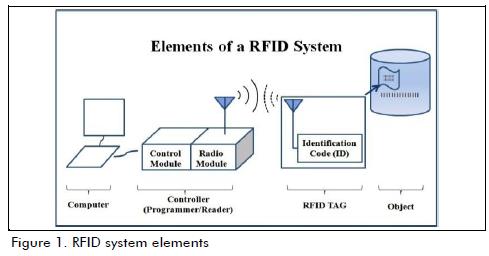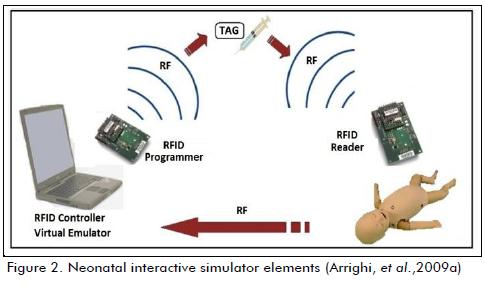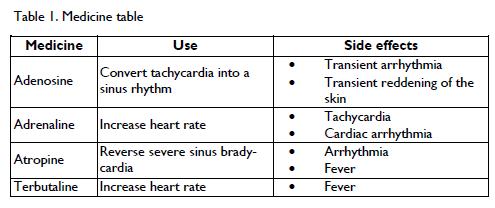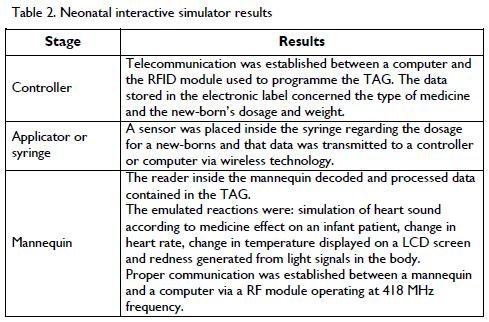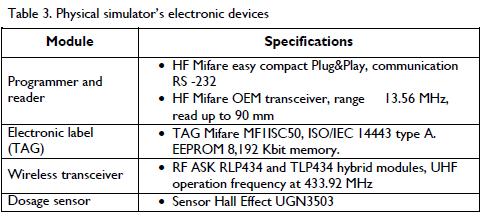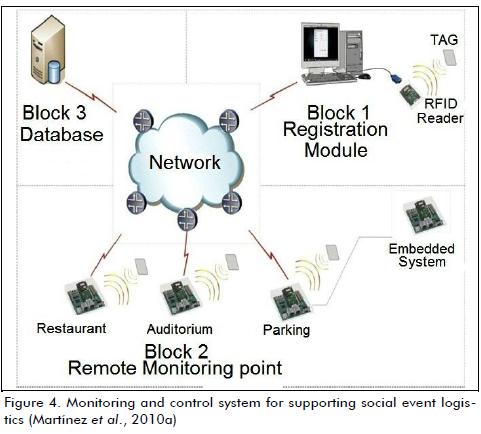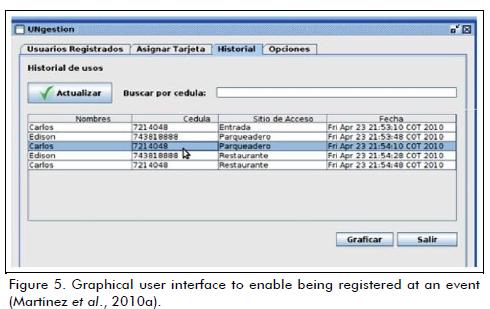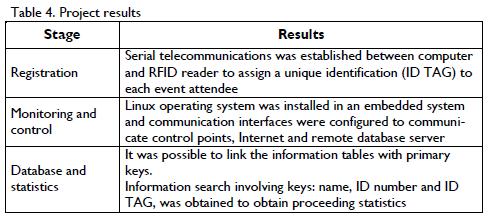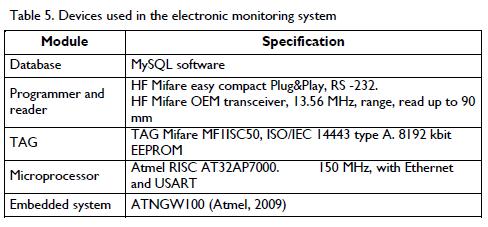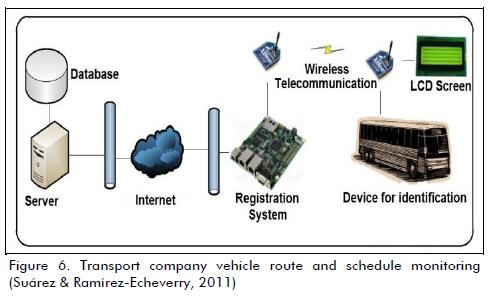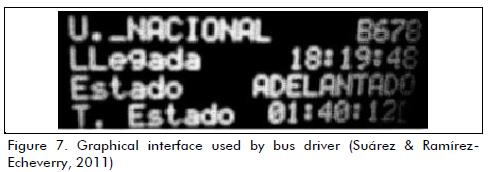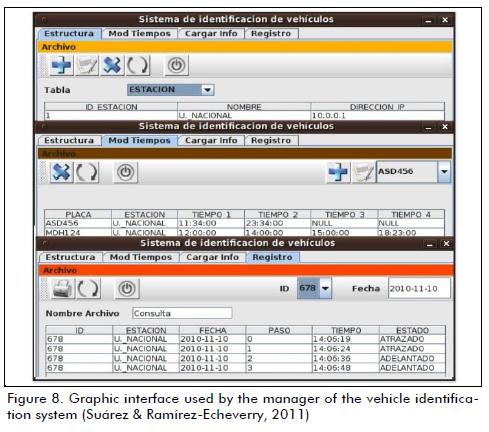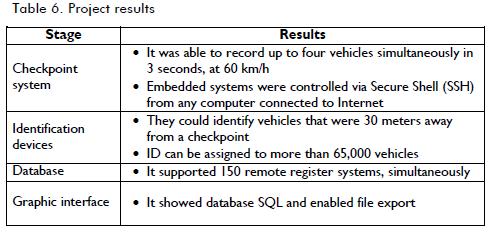Servicios Personalizados
Revista
Articulo
Indicadores
-
 Citado por SciELO
Citado por SciELO -
 Accesos
Accesos
Links relacionados
-
 Citado por Google
Citado por Google -
 Similares en
SciELO
Similares en
SciELO -
 Similares en Google
Similares en Google
Compartir
Ingeniería e Investigación
versión impresa ISSN 0120-5609
Ing. Investig. vol.32 no.3 Bogotá dic. 2012
Radio frequency identification (RFID) technology for academic, logistics and passenger transport applications
Sistemas de telecomunicaciones basados en identificación por radiofrecuencia para aplicaciones académicas, de logística y transporte de pasajeros
J. J. Ramírez1
1 John Jairo Ramírez Echeverry. Affiliation: Universidad Nacional de Colombia, Bogotá. Electronic Engineer, Master Science of Telecommunication of Universidad Nacional de Colombia, Bogotá, Specialist in Networks and Telecommunication of Universidad de Manizales, Manizales. Director of Grupo de Investigación en Electrónica de Altas Frecuencias y Telecomunicaciones –CMUN, Universidad Nacional de Colombia. E-mail: jjramireze@unal.edu.co
How to cite: J. J. Ramírez. (2012). Radio frequency identification (RFID) technology for academic, logistics and passenger transport applications. Ingeniería e Investigación. Vol. 32, No. 3. December 2012, pp. 58-65.
ABSTRACT
Radio frequency identification (RFID) technology, from its beginning in the 1980s, has provided solutions in areas in which no identification (ID) technology has done so before. This paper presents three applications in areas having an issue in common: an RFID technology-based solution; these fields were academic topics, logistic support for an event and passenger land transport. Each project identified a problem which needed resolving, the methods and electronic devices used for such solution and the outcomes achieved. The developments shown in this paper indicated the multidisciplinary nature of RFID technology because it achieved new solutions for identifying objects or people in many contexts and not just the consumer goods trade which is the application nowa-days most known for using this technology. These projects were developed by members of the Universidad Nacional de Colombia's High Frequency Electronics and Telecommunications Research Group (CMUN) (website: http://www.cmun.unal.edu.co).
Keywords: Wireless communications system, radio frequency identification (RFID), neonatal medical simulation mannequin, event logistics, vehicle identification, ZigBee.
RESUMEN
Este artículo presenta resultados de tres proyectos desarrollados por el Grupo de Investigación en Electrónica de Altas Frecuencias y Telecomunicaciones, de la Universidad Nacional de Colombia (CMUN), en los cuales se han implementado sistemas de telecomunicaciones inalámbricos, basados en tecnologías de identificación por radiofrecuencia (RFID), para el entrenamiento médico de estudiantes de neonatología, manejo de logística de eventos y monitoreo de rutas y arribo de vehículos de transporte de pasajeros. El primer proyecto permitió mejorar la tecnología de telecomunicaciones de los simuladores de entrenamiento para estudiantes de medicina y enfermería en el área de neonatología de la Universidad de Colombia. Con el sistema para apoyo a labores de logística se logró una herramienta que controla autónomamente el ingreso de asistentes a las diversas actividades de un evento y recolecta de modo remoto datos para obtener estadísticas de participación de los asistentes en cada actividad programada. En el último proyecto se implementó un sistema que identifica vehículos que circulan a una distancia máxima de 100 m de un punto de control, con el fin de verificar el cumplimiento de rutas y de horarios del parque automotor de una empresa sin la presencia de un operador. Al final del artículo se hace un análisis de los principales logros alcanzados en cada uno de los proyectos realizados con tecnologías RFID.
Palabras clave: Comunicaciones inalámbricas, Identificación por Radio Frecuencia (RFID), simulador médico, logística de eventos, reconocimiento remoto de vehículos, ZigBee.
Received: June 21th 2011 Accepted: August 27th 2012
Introduction
Radio frequency identification (RFID) technology has transformed object and people identification methods during the last three decades because it is wireless and does not require physical contact between an identified object and the reader or the identifier device (Roberti, 2010). This technology has led to electronic solutions for automatic identification in many environments, including automatic payment systems, access control and asset tracking (RFID Journal, 2012).
The projects presented in this article were developed for academic, industrial and passenger transport environments because there was a need for automatically identifying people and objects which could be solved using RFID technology. These needs could be solved using other technologies such as bar codes, but these involve the difficulty of requiring contact between an identification card and a barcode reader. This paper presents three automatic identification prototypes in the aforementioned environments. Field tests were conducted demonstrating the functionality of passive RFID devices in identifying objects and people, and the usefulness of adding telecommunication devices having remote databases for recording and storing identified data.
The first project was a health training module used by medical students and nurses in neonatal clinical preparation. The module consisted of a neonatal mannequin for simulating diseases like redness, cardiac arrhythmia and tachycardia in new-borns. A teacher activated simulation of the above scenarios and a student chose the medicament and dose to deliver to the "patient". RFID technology led to identifying the medicament which a student would give the "patient". Once a medicament had been identified, the mannequin simulated positive or negative effects regarding the treatment which a student had applied before.
The second project involved a module for supporting a social event's logistics. RFID technology led to identifying each person attending a social event. It was an electronic system autono-mously controlling attendees entrance to scheduled activities and recorded the participants' data in a remote database for statisti-cal purposes. Data was sent to a remote computer using embed-ded systems and statistics allowed real-time monitoring of the scheduled activities. This work enabled the CMUN group to make advances regarding centralising information obtained through RFID identification systems and reach a scalable solution according to the needs arising from a social event's logistics.
The third project involved development for a land passenger transport area. It was an electronic means of identifying moving vehicles, verifying a passenger transport company's compliance with routes and schedules without the need for people to oversee route operations. This work integrated wireless technologies, embedded systems, the Internet and database design.
Background and justification
Interactive medical simulators
100 million babies are born each year around the world, around 10 million of whom need assistance to start breathing and 1 million of them need cardiopulmonary resuscitation (CPR) (Mur-phy & Halamek, 2005). Unwanted events in medical practices involving neonates may produce serious problems in baby for-mation and growth. Giving medical and nursing staff suitable training and learning before they care for real patients becomes a decisive factor in saving lives and ensures proper prognosis (Arrighi et al, 2011). Teachers and researchers in the field of medicine have developed tools for medical simulation based on computers and mannequins allowing students to experiment with unreal patients and overcome some limitations involved in cur-rent medical training (Ziv, et al., 2006; Korosec et al., 2005; Murphy & Halamek, 2005; Halamek et al., 2000; Ostergaard et al., 2004).
However, commercial simulators are expensive and practice regarding the pathologies which students may develop with them are set by the designers without being able to adapt to different countries' healthcare sector conditions (Arrighi, et al., 2011). Most of these simulators have limited telecommunications infra-structure as they use wired connections between the controller and the mannequin. This telecommunication infrastructure may be replaced by wireless technologies and RFID to improve similarity between a training environment and the actual environ-ment involving a patient.
Given the importance of the topic and the restrictions men-tioned above, CMUN proposed a project to provide a virtual and physical simulation tool to teach students the application of umbilical puncture medicaments from medical interpretation of a patient's symptoms.
Automating social meetings' logistics
A social meeting is an important and programmed event, i.e. social, artistic, athletic, academic events. A social meeting may take the form of a seminar, workshop, conference or exhibition festival (Martinez, et al., 2010a). The development of an event involves a lot of logistical activities to ensure a successful result and requires rigorous organisation and audience management techniques. Many of these activities are related to identifying who is attending the event and controlling entry to places where different kinds of activities take place.
Nowadays, using people to control access to social events is not reliable in most cases and does not enable obtaining statistics in real time because control is manually done using ballots, handles, rosettes and, in a few cases, barcode systems. A large staff is thus required, for a long time, and event development is hindered and becomes expensive due to increased costs (Martínez et al., 2010b). Such control access methods only allow controlling participants' entry but they do not provide the ability to perform an automatic inventory.
Given these needs, an electronic system was developed for supporting social event logistics enabling automatic identification of attendees, verifying data and obtaining information before, during and after completing a particular social event to have real time stats concerning people attending activities/events.
Transport company vehicle route and schedule monitoring
To improve the quality of urban passenger transport companies' service, company managers must ensure that their drivers comply with the routes and schedules which have been assigned to them by the company. This requires internal controls for collect-ing and analysing information regarding vehicle compliance with routes and their duration. Most companies in Colombia hire an operator to perform this task by identifying and recording the time at which a vehicle passes through a checkpoint in the city. Data is taken manually and must be validated by the vehicle driver's signature (Suárez & Ramírez-Echeverry, 2010).
This monitoring technique has weaknesses such as high operator risk because he/she could be run over by vehicles passing through a particular checkpoint. Vehicles being monitored must stop at each checkpoint, resulting in service delays and blocking the transit of other vehicles using the route. Other limitations regarding the current monitoring technique involve an operator only being able to attend one vehicle at a time and manually recorded data is more susceptible to error compared to data automatically obtained by an electronic system (Suárez & Ramírez-Echeverry, 2010).
The vehicle arrival monitoring system developed in this project provided a complete solution to current deficiencies in vehicle monitoring systems for urban passenger transport in Colombia (Suárez & Ramírez-Echeverry, 2010).
Theoretical Framework: Object Technology Identification
Automatic identification (auto-ID) refers to any means or pro-cess used to automatically recognise a person or physical object, such as animals, moving goods or products (Dobkin, 2008; Finkenzeller, 2010).
Automatic identification systems have taken on considerable importance in recent years in areas such as event logistics, distribution and monitoring material flow in businesses, transportation and personal identification. Some automatic identification tech-nologies, including RFID which was used in the projects present-ed in this paper (Finkenzeller, 2010) are given below.
Bar codes
They consist of an array of signs (lines and spaces) formed by a binary code placed on products to identify elements within a group. They are most frequently used in computerised stock management. The information contained in the code is decoded by a laser scanner able to identify each element's sequence and associate such sequence with specific data corresponding to each element. This technology requires physical contact and line of sight between the laser and the overlay code to identify a specific object.
Biometric methods
Biometric technique methods are used in automatic identification to recognise people by comparing an individual and each individual's unique physical characteristics.
Voice recognition and fingerprinting are the most common biometric methods.
Smart cards
These are electronic systems which are put inside a card for data storage. When a card is inserted into a reader terminal it can recover the information recorded on the card via bidirectional data exchange. There are two types: read-only smart card or microprocessor incorporated smart card. Read-only smart card has an electrically erasable programmable read-only memory (EEPROM) chip on which data can be recorded by the manufacturer or by the user. These cards can have security algorithms to prevent card hacking.
Cards having a microprocessor are memory cards with an additional microprocessor allowing them to store data, adapt to new applications and incorporate tools for high security developments.
Radio frequency identification (RFID)
RFID is a system that sticks an electronic label or "TAG" to a physical object which must be identified, tracked and monitored by radio frequency and computing devices (Brown, 2007). This technology does not require physical contact between the reader/programmer TAG and TAG. The basic elements of a RFID system are a computer system or controller, a programmer device, a card reader or interrogator and a TAG which is attached to the object. Such elements are shown in Figure 1.
Before starting to operate an RFID system, the software and applications installed on a computer allow recording data in the EEPROM module inside electronic TAGs. This recording includes memory writing by programmer operation and previously stored data in EEPROM allows object identification. Recorded TAGs are then attached to the object in question.
When RFID is used, a programmer or reader emits radio fre-quency signals which are tuned by nearby TAGs. In turn, the TAG responds with information contained inside it, including its unique identification code so that identification is recovered by the reader to be sent to the computer system. The controller stores the information regarding the objects which have been identified by the reader or interrogator within the pertinent coverage area.
The controller could be a computer or an embedded system.
The programmer or reader is a device for writing or reading that recognises the presence of RFID TAGs within coverage. Write mode modifies the data contained in EEPROM memory TAG and reading mode retrieves such information.
The e-label or TAG is the component that allows identification of the object or device that carries it. It consists of a semiconductor chip, an antenna (encapsulated) and occasionally a battery (active TAG). basic TAG functions are: save data identifying an object or save a detailed description of it and send that data to the reader when requested by radio frequency signals sent by the reader module.
RFID is a solution for identifying objects without physical means of contact between the identifier and the object.
Projects dealt with here
Emulating medicament prescription using medical training mannequins
Training future healthcare professionals regarding their clinical skills before attending patients is very important because it al-lows them to be prepared for making quick and accurate deci-sions when facing situations in which the life of a person can be at risk (Caracol Radio, 2008). Interactive simulators have been developed with computational tools and mannequins in recent years allowing medical and nursing students to experience diagnosing and prescribing medicaments in a pathological or non-pathological medical scenario.
The Universidad Nacional de Colombia's Medicine and Engineering Faculties decided to implement a training laboratory prototype, as shown in Figure 2, because they were concerned by the need to have a physical, virtual and interactive simulator (manne quin) of a neonatal patient. The simulator had to be low cost, allow medical and nursing students to perform neonatal clinical course practice and have a wireless telecommunications system to send data from a mannequin to a computer, without guided means (copper wire).
The medical training laboratory was thus designed to start when a teacher triggered a clinical stage in the mannequin by setting switches mimicking symptoms such as reddening of the skin, arrhythmia and tachycardia. A student then had to make a diagnosis and choose medication to be provided for the "patient" through a graphical interface in the computer, as shown in Figure 3.
The student continued the practice by selecting the dose to be given to the "patient" by manipulating a syringe. Data regarding the dose to be given was sent to the computer through a wire-less transmitter from the syringe.
Once the learner had chosen the type of medication and dose, the computer and RFID recorder saved this information on a RFID TAG memory (TAG), located in the syringe.
A student then had to bring the TAG near to the "patient" (man-nequin) which had a RFID reader able to recover data regarding the medicament and dosage to be applied. From this information a microprocessor, inside the mannequin, activated devices emulating favourable or unfavourable symptoms regarding the new-borns' health.
The patient's health status was sent to the computer through a wireless link, to be virtually emulated.
Accordingly, the medical scenario symptoms posed by the teacher and the results of the medicament applied by the student following their diagnosis were physically represented in the mannequin and virtually on the computer to inform a student whether the treatment so prescribed for the "patient" was appropriate.
Table 1 lists some medicaments and their most common uses which were used to generate a bank of training scenarios for the students. The decision regarding the type of medicament and dosage depended on the "patient's" condition and weight. The mannequin had to react to each decision, unless the syringe had not been supplied with medicine. In case of overdose, adverse effects had to be presented in the "patient".
For example, if the "patient" had tachycardia and weighed 1 kg, the student would have injected a 0.2 ml dose of adenosine, applying it repeatedly until heart rate returned to normal. If the medical setting was the same and a student had applied a 1 ml adenosine dose, then the mannequin would have simulated cardiac arrest and reddening. Another example would be if the "patient" suffered cardiac arrest and weighed 1 kg, then the student would have had to have applied terbulatine in small doses (less than 0.5 ml). In such case, if a student had applied 1 ml terbulatine, the mannequin would have experienced tachycardia and fever.
Table 1 shows that the medicines listed there could have modified respiratory rate and temperature, so the mannequin had to contain electronic devices to emulate the sound of the heart at different frequencies (i.e. tachycardia, bradycardia or normal frequency). To emulate fever, light emitting diodes (LED) were conditioned to indicate reddening and a LCD display showing a baby's pulse and temperature.
Table 2 shows the project results regarding each simulator component. It was concluded that the simulator had more real char-acteristics than those presented by commercial simulators, due to wireless telecommunication between project components (Arrighi et al., 2009b).
Table 3 gives the electronic device specifications used by each simulator module.
Medical and nursing students could thus self-assess their diagno-ses made directly from a "patient's" health condition. Further more, a teacher could assess a learner's ability regarding an emergency case involving a real baby.
Although RFID technology seeks to improve the shortcomings of object identification technologies, this project led to obtaining an interdisciplinary solution for a specific need applied to medical training.
Control and monitoring system to support event logistics
Figure 4 gives the proposed system block diagram; it has three parts: registration module attendees, remote points to monitor and control, and database.
Block 1 shows the registration step when the participant was entered into the information system regarding the proceedings and the participant received an RFID tag (TAG) with identification (ID) or unique ID card ensuring an identity within the system.
Registration was done through a graphical user interface built on Linux (see Figure 5) which could perform the following tasks:
- User registration: selecting event activities in which an attendee could participate;
- Assigning each user identification by RFID ID card. The RFID reader would read the ID;
- Searching records in an information system for the event through citizen identification card number, name or ID TAG;
- Viewing historic entries regarding event activities, time and place; and
- Presenting event statistics graphics.
Figure 5 shows user input characteristics with suitable identifica-tion and options for generating permission for each person to participate in one or more activities during a particular event.
When an attendee had registered at an event and had been given an RFID TAG, he/she could participate in those activities to which she/he had become entitled. To enter an activity, she/he had to go to the remote monitoring and control point (Block 2, Figure 4) and bring her/his RFID TAG to the reader to be identified. The smart control module for each reader used an embed-ded system. The monitoring points were located at the entrance to an event restaurant or parking service or entrance to an auditorium where a lecture would be given, or other related situation/event activity.
A monitoring module identified the user, received the information from the TAG and sent such data over Internet to the server database (Block 3, Figure 4) to see whether a user had permission to enter a particular activity. The answer to this query was sent back to the remote control point and the answer was displayed using LEDs.
Participants' attendance at each activity was recorded in the database to obtain statistics during and after the event. Table 4 gives the project outcomes.
An electronic system was thus set up to support a social event's logistics, allowing event participants' registration, identifying and verifying data through Internet, without the need for a computer at each checkpoint.
The system obtained realtime statistics regarding people's en-rolment and attendance at scheduled activities.
Table 5 presents the specifications of the electronic devices used by each module in the monitoring and control system to support event logistics.
Transport company vehicle route and schedule monitoring
Companies in Colombia transporting urban passengers must fulfill quality criteria regarding the services they provide for their users. The main criteria defined for such purpose are: completing each set route, scheduling a suitable frequency for vehicles on each route and making the journey at a convenient speed/time to prevent accidents caused by speeding or to avoid delays to the users by slowness.
To monitor the service provided by drivers, checkpoints are established to register vehicles passing such points to determine whether they are making the entire journey established for a specific route. Arrival time at a control point is recorded to compare it to the expected arrival time, thus making it possible to determine whether a vehicle's average transit speed is appropriate.
This project was thus aimed at developing an electronic system for automatically identifying/monitoring urban transport compa-nies' vehicles, without needing a person to physically check them at each checkpoint. It sought to avoid risks to the lives of people who are currently doing this manually, to avoid transport service delays due to vehicles being detained at each checkpoint and avoid blocking other vehicles using the route where the check-points are.
Figure 6 shows the system used for vehicle arrival identification.
All routes, with their corresponding schedules, were set in a database according to what a transport company was offering its users. In this programme, each company vehicle was assigned a specific route. This information was stored in the monitoring system database and sent via Internet to each registration module (registration system) located at each control point on a par-ticular route.
Each company vehicle had a wireless telecommunications device with a unique ID. Therefore, when a driver drove the route assigned to a particular vehicle, it could be recognised at each checkpoint. Whenever the vehicle passed one of these check points, the registration system recorded vehicle identification, date and time and calculated any advance or delay in fulfilling scheduled route time. This data was sent to the bus via a wire-less telecommunication system to inform a driver of compliance with route status. The registration system sent vehicle and checkpoint arrival time information to the database via Internet so the company staff could obtain and analyse service statistics being provided regarding all routes with all vehicles.
According to the above description, the system consisted of three modules: database, identification device registration system and wireless communication.
Database:
The database in the computer was built using MySQL language and was responsible for:
- Saving reports sent by the registration system when a vehi-cle had been identified; and
- Obtaining performance statistics regarding each vehicle in real time.
A TCP/IP server was configured in the computer to receive data simultaneously from all recording systems along the routes where the company provided a service.
Registration system (checkpoint):
The registration and identification system used an embedded system (NGW100 ATMEL) and a transceiver (XBee) operating on 2.4 GHz ISM band (IEEE 802.15.4). Both elements were located at each checkpoint and were responsible for identifying the vehicles, recording the date and arrival time of a particular bus at a specific checkpoint and sent this information to the database by TCP/IP and to the vehicle, which had another XBee transceiver.
The XBee transceiver modules were programmed through the embedded system.
Identification and wireless communication devices:
The bus driver could see, through a LCD screen, the results obtained from the checkpoint system. Data received in the vehicle via an XBee transceiver were:
- Vehicle arrival time at a particular checkpoint;
- Status: early, delayed or on time;
- The time associated with where a particular vehicle was; and
- The name of the next station and estimated passing time.
Figure 7 presents an LCD screen with data received by a bus driver.
A graphic user interface built using Java language was created for administering this system; it was responsible for displaying information received from each node over Internet and stored in the database. Figure 8 shows such graphic user interface (GUI).
This GUI was divided into four segments: structure, timetable, sending data and registration. Database system information was inserted, modified or deleted in the first two segments; the third segment was responsible for sending the necessary information to each checkpoint operation and the fourth segment showed statistics or reports generated by the system.
Table 6 gives the project results.
The electronic vehicle identification system allowed transport companies to monitor their buses autonomously, with low error probability in the recorded data and without needing the pres-ence of an operator at a particular control point.
Because this system simultaneously identified vehicles moving at a 30 meter distance from the control point, it avoided unneces-sary stops being made by a bus. This enabled a bus to make its way continuously without obstructing other vehicles using such route/road.
Conclusions
RFID technology is a tool providing practical solutions for problems involving object or person identification in many contexts related to any discipline. The work presented in this article has reflected multidisciplinary application fields for this electronic technology.
A neonatal simulator, as presented in this paper, is useful for training students in health sciences by allowing them to acquire new knowledge and professional skills, making decisions quickly and safely, training in managing equipment and acquiring practical clinical experience. RFID technology enabled this practical tool's use.
Multidisciplinary research on neonatal simulators, including medical staff, engineers and/or industrial designers has created a rich space for sharing knowledge and experience. Each discipline's specificities have created working synergy, an atmosphere of mutual trust and an initial solution to high-cost, wired telecom-munication neonatal simulators.
RFID technology has extensive documentation and a broad background making it a support tool in implementing a project for monitoring and controlling events. In the proposed logistical support for social events presented in this paper, RFID perfor-mance was enhanced through the synergy achieved by joining embedded systems and databases, thereby increasing the scope of the project by interconnection, dataprocessing, networking and managing graphic interfaces and other convergence designs.
The automatic vehicle identification system presented in this paper could be adapted to multiple contexts such as paying tolls, vehicle entrance to and exit from a parking lot, school route control and other traffic situations.
Acknowledgement
The results presented in this paper came from the efforts of and teamwork by engineers from the High Frequency Electronics and Telecommunications Research Group (CMUN): Arrighi Loreana Quintero, Daniel Fonseca Eduardo Hidalgo, Edison Arley Niño Torres, Edwin Javier Martinez Mesa and Camilo Alexey Suárez Buitrago.
We would also like to thank Dr. Luis Mendez for his guidance in the medical field and Andres Triana and Juan F. Coronel for their suggestions in writing this article.
References
Arrighi, L., Fonseca, D. E., & Ramírez-Echeverry, J. J., Implementación de un módulo basado en tecnología RFID para la emulación del suministro de medicamentos, reconocimiento y respectiva reacción, en un maniquí de entrenamiento médico. Universidad Nacional de Colombia, Ingeniería Eléctrica y Electrónica, 2009ª, Bogotá [ Links ].
Arrighi, L., Fonseca, E., & Ramírez-Echeverry, J., Development of a neonatal interactive simulator by using an RFID module for healthcare professionals training. En C. Turcu (Ed.), RFID Book (Vol. 3). Rumania: Intech. 2011 [ Links ]
Arrighi, L., Fonseca, E., & Ramírez-Echeverry, J., Implementation of an RFID based module for the emulation of drug prescription in a medical training mannequin. IEEE Latin American Communications Conference, LATINCOM (págs. 1-6). Medellín: Institute of Electrical and Electronic Engineer, IEEE. 2009b [ Links ]
Brown, D. E., RFID Implementation. McGraw-Hill. 2007. [ Links ]
Caracol Radio. Caracol Radio Actualidad. Recuperado el 01 de 06 de 2011, de Government calls upon the Prosecutor to investigate the death of a child for alleged medical error: http://www.caracol.com.co/nota.aspx?id-=542017 [ Links ]
Dobkin, D., The RF in RFID. Newnes. 2008 [ Links ]
Finkenzeller, K., RFID Handbook. Willey. 2010. [ Links ]
Grupo de Investigación en Electrónica de alta frecuencia y telecomunicaciones. Wiki CMUN. Recuperado el 12 de 09 de 2012, de http://www.cmun.unal.edu.co/ [ Links ]
Halamek, L., Kaegi, D., Gaba, D., Sowb, Y., Smith, B., Smith, E., y otros., Time for a new paradigm in pediatric medical education: Teaching neonaltal resuscitation in a simulated delivery room environment. Journal Pediatrics, 2000, pp. 106-110. [ Links ]
Korosec, D., Holobar, A., Divjak, M., & Zazula, D., Building interactive virtual environments for simulation training in medicine using VRML and Java/Javascript. Journal Computer Methods and Programs in Biomedicine, 2005, pp. 80. [ Links ]
Martínez, E. J., Niño, E., & Ramírez-Echeverry, J., Sistema para control y monitoreo en logística de eventos basado en RFID. Universidad Nacional de Colombia, Ingeniería Eléctrica y Electrónica, Bogotá. 2010ª [ Links ].
Martínez, E. J., Niño, E., & Ramírez-Echeverry, J., Sistema para control y monitoreo en logística de eventos basado en RFID. Memorias III Congreso Internacional de Telecomunicaciones, Tecnologías de la Información y las Comunicaciones. Quito (Ecuador). 2010b [ Links ]
Murphy, A., & Halamek, L., Simulation-based training in neonatal resuscitation. Journal Educational Perspectives , No. 6, 2005, pp. 489-492. [ Links ]
Ostergaard, H., Ostergaard, D., & Lippert, A., Implementation of team training in medical education in Denmark. Journal Qual Saf Health Care , Vol. 13, 2004, pp. 91-95. [ Links ]
RFID Journal., RFID Journal. Recuperado el 12 de 09 de 2012, de What are some of the most common applications for RFID?: http://www.rfidjournal.com/faq/16/56 [ Links ]
Roberti, M. RFID Journal. Recuperado el 12 de 09 de 2012, de The History of RFID Technology: http://www.rfidjournal.com/article/view/1338 [ Links ]
Suárez, C. A., & Ramírez-Echeverry, J., System for identification and control of arrival of vehicles. Memorias II Congreso Nacional de Telecomunicaciones. Arequipa (Perú). 2011 [ Links ]
Suárez, C., & Ramírez-Echeverry, J., Sistema de identificación y control de arribo de vehículos. Universidad Nacional de Colombia, Ingeniería Eléctrica y Electrónica, Bogotá. 2010 [ Links ]
Ziv, A., Wolpe, P., Small, S., & Glick, S., Simulation-based medical education: An ethical imperative. Journal Simul Healthcare, 2006, pp. 252-256. [ Links ]













